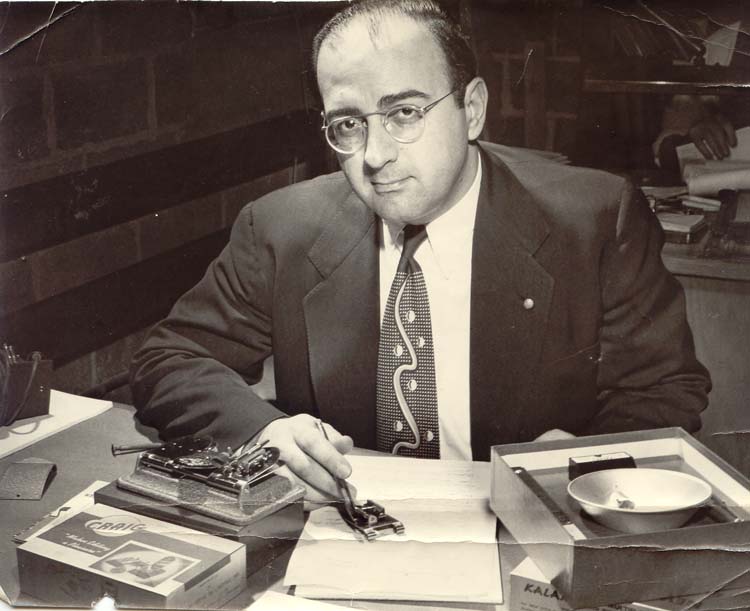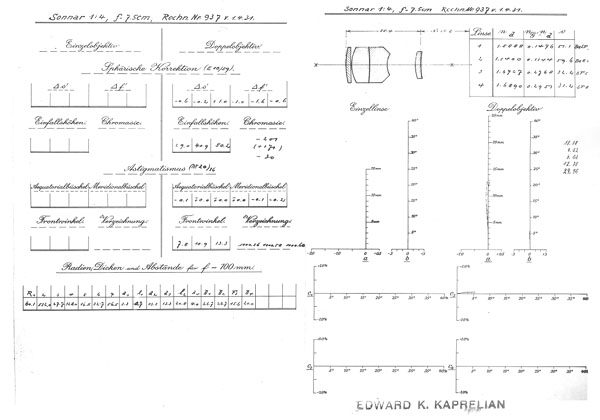
| Return to Biographical page | Return to home page |
 |
Ed Kaprelian's profession was that of an optical, mechanical and photographic professional. He was also a devoted collector of photographic apparatus and spoke often to collecting groups on diverse subjects related to nearly every element of photography.
He had graduated with a Masters in Engineering from Stevens Institute of Technology in 1934 and began his professional career as a patent examiner. As World War II began, he moved to the position of Physicist and Chief of the Manufacturing Section of the Foreign Economic Administration in Washington, DC. At the end of the war, he became the Chief of US Army Signal Corps Engineering Labs in Fort Monmouth, NJ. He moved from prestigious to prestigious position with the Kalart company, the US Army Signal Research and Development Lab, and served as the Technical Director of Keuffel and Esser and the US Army Limited War Laboratory. In his spare time, he was a Lieutenant Colonel in the US Army Reserve. He held more than 50 US and foreign patents and was the author of numerous technical papers, encyclopedia articles and book reviews.
He was also a collector of photographic apparatus and materials for most of his life. When most camera collectors began to think of collecting, Ed already had samples of the most innovative items in his lab. Most of the photographic collecting societies became active beneficiaries of his knowledge and experience. He was gracious and forthcoming to all.
He acted as a consultant to the Photographic industries well beyond normal retirement age and was listed in Who's Who in America, Who's Who in Engineering, and American Men of Science.
He was familiar with Zeiss Ikon and Carl Zeiss products which were a significant portion of his collection and was familiar to the Zeiss firm in his professional capacities. While he was with the Signal Corps, many Carl Zeiss optical designers accepted contracts to work here in the United States under his direction. The famous Zeiss lens collection was appropriated as war reparations by the US Army in May 1945 and sent to the US where it came under his control. None of these nearly 2000 historically and technically significant lenses had been clearly documented as part of the appropriation. At that time, he had on his staff Dr. Willy Merte. Merte had been the head of optical computation at Carl Zeiss Jena and was languishing in a refugee camp in Heidenheim before Carl Zeiss could begin operation in Western Germany. Merte was familiar with the collection and cataloged all of the 2000 lenses for US military and civilian use.
After Kaprelian's release from his military service, the lens collection was left in the custodian ship of the firm of Burke and James in Chicago and occupied space in their warehouses for some 20 odd years. Later, when the firm questioned whether it should continue to be maintained, no one in the military could answer this question and so it was disposed of as surplus material via a mail order business and dispersed. Since he was in private business, no one approached Kaprelian on this matter. However, the firms of Carl Zeiss in Oberkochen and Carl Zeiss Jena in East Germany both sought to reacquire it from time to time but, unfortunately, due to red tape and lack of knowledge as to where it was, they did not find those who were in possession of the collection.
 |
This is a lens data card that was prepared to document one of the lenses that was in the Zeiss lens collection confiscated by the US military. This shows all of the pertinent technical data for a version of the Sonnar lenses developed for the Contax camera. This F/4 7.5 cm lens was never produced. This card is dated April 1, 1931. |
Articles on the Zeiss Lens Collection:
E. Kaprelian, The Fabulous Zeiss Lens Collection: A Memoir, Photographica (New York Photographic Historical Society). 55-59, 1978
E. Kaprelian, Recent and Unusual German Lens Designs, Journal of the Optical Society of America, Vol. 37, No. 6, 466-471, June 1947
E. Kaprelian, Lens Oddities, Popular Photography, 82-3, April 1947